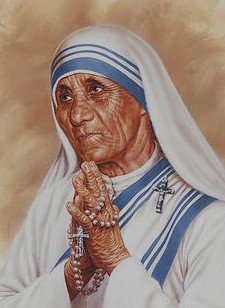
 "Mother Teresa" says she received a vision from God telling her to help the poor while living among them. Following some very basic medical training, she started to look after the "poorest among the poor," those who were dying or were destitute on the streets in the slums of Calcutta. In 1952 her "Missionaries of Charity" organization started the Kalighat Home for the Dying -- "a place where people could come to die in dignity and comfort." She wanted to make it possible for "people who lived like animals to die like angels -- loved and wanted."
"Mother Teresa" says she received a vision from God telling her to help the poor while living among them. Following some very basic medical training, she started to look after the "poorest among the poor," those who were dying or were destitute on the streets in the slums of Calcutta. In 1952 her "Missionaries of Charity" organization started the Kalighat Home for the Dying -- "a place where people could come to die in dignity and comfort." She wanted to make it possible for "people who lived like animals to die like angels -- loved and wanted."
When qualified doctors visited the Kalighat facility, they found that medical care was almost non-existent. Most of the volunteers had no medical knowledge, but had to make medical decisions because there were no doctors present. There was no distinction made between those who were suffering from curable vs. incurable illnesses, so that people who might have survived (had they been given access to treatment) were left to die. Needles were re-used so many times that they became blunt, and they were not sterilized between uses.
In 1981, when the state of care in her facilities was questioned, she said, "There is something beautiful in seeing the poor accept their lot, to suffer it like Christ's Passion. The world gains much from their suffering."
There was no proper pain management. People suffered needlessly before they died.
There is a story about a time when one of her "patients" was dying in pain, and she told him, "You are suffering; that means Jesus is kissing you." The sufferer responded: "Tell your Jesus to stop kissing me!"
For her own medical treatment, Mother Teresa received only the best. Although she made public shows of declining free high-quality medical treatment, she had no compunction about secretly accepting medical care from the best institutions in the world, including having cataract surgery and having a pacemaker installed. When the time came for her to be "kissed by Jesus," she did not die in one of her own homes for the dying, and was not treated with blunt needles. She died in the very best of medical facilities.
Despite the extensive donations to Mother Teresa's homes, only a few hundred people are helped at any one time. When she accepted her Nobel Peace Prize, Mother Teresa claimed to have helped 36,000 people in Calcutta; the reality is that the Missionaries of Charity has "helped" about 700 people. A survey of charitable organizations operating in Calcutta in 1998 did not even rank her facilities in the top 200. Some of the Missionaries of Charity homes are used not to treat sick people but to try to persuade them to convert to Catholicism.
Mother Teresa's organization received extensive donations which would have enabled it transform the "homes for the dying" into modern, clean hospices that would provide a decent level of palliative care. But Mother Teresa was not interested in mitigating suffering; in fact, she celebrated it. She concentrated on opening new Missionaries of Charity convents and homes in different locations around the world instead of using its extensive funds to renovate and upgrade the existing homes.
There have been well-documented cases of people trying to access the services of Mother Teresa's house for the dying but being turned away. In one instance in 1979, shortly before the Nobel Peace Prize ceremony, a well-known Calcuttan intellectual, Jyotirmoy Datta, tried to obtain the assistance of the House of the Dying for a destitute man he found on the street. He spoke to Mother Teresa herself, who refused to help.
Under Indian law, all charities are required to publish their financial records, but the Missionaries of Charity never complied with this requirement. In Germany, when the Missionaries of Charity were asked how much money they had, they responded that "It's nobody's business." In New York, a former Sister with the Missionaries of Charity said that in one year the organization banked $50 million. She thought that the organization's receipts worldwide would amount to somewhere in the region of $100 million annually.
There is no record of expenditures made by the Missionaries of Charity. Wherever possible, they rely on in-kind donations - of food, clothing, buildings, etc., to cover their startup and operating costs. It appears that a significant portion of monetary donations are deposited at the Vatican Bank in Rome and are not used to improve the houses of the dying or the "charitable operations" of the order.
Mother Teresa was happy to accept donations from any source - even when the source in question was a reprehensible criminal con-man.
She received significant donations from Charles Keating, a leading American catholic who was convicted and imprisoned for fraud when his Savings and Loan Association collapsed, leaving 23,000 investors with worthless bonds, and from Robert Maxwell who stole £450 million from the pension fund of his employees.
Mother Teresa wrote to the judge requesting leniency for Keating because he had made donations to the Missionaries of Charity. The Deputy District Attorney wrote to her explaining exactly what Keating had done (defrauding small investors of their life savings) and suggested that she return the donations to the victims of Keating's crimes.
Mother Teresa didn't even reply to this letter.
And she did not return the money.
Christopher Hitchens wrote a book about her.
And here's another informative book.
|
|

|